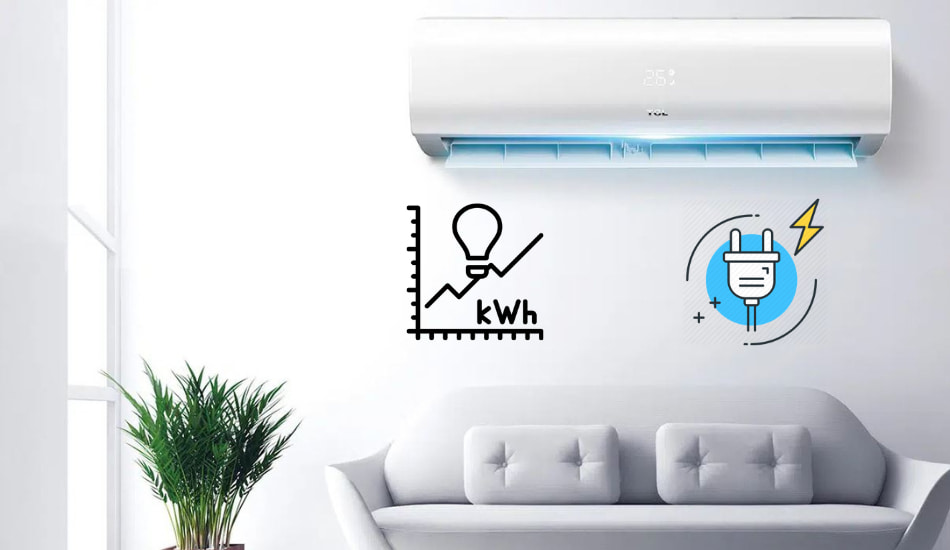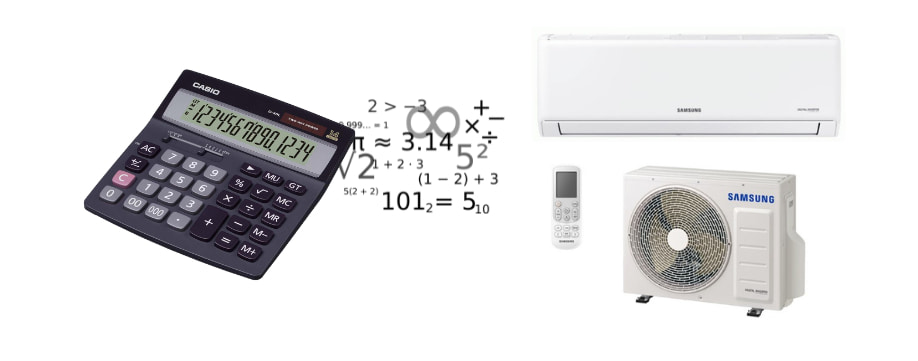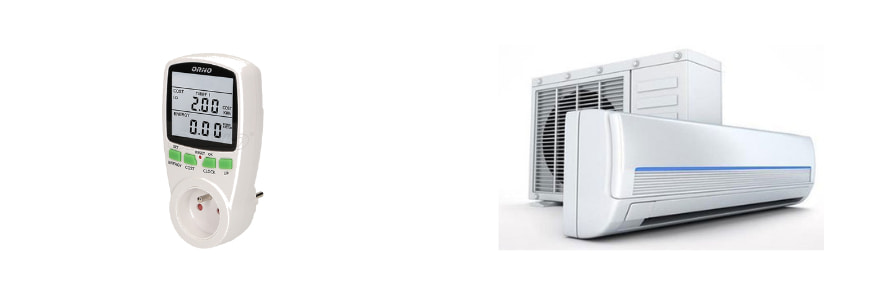How Much Power (Watts) Does An AC Use?

Nowadays, AC can be found in almost every house. They help us beat the sweltering summer heat, providing a cool sanctuary in our homes. But while we enjoy the comfort, our air conditioners consume electricity.
Although we know that our air conditioners use power, their consumption often remains a mystery. In this article, we’ll talk about how much electricity they consume and what affects their power consumption. So, let’s start!
How Much Power Does An AC Use? An AC typically consumes around 3,000 watts per hour. If left running for a full 24-hour day, this equates to a significant 72,000 watts of electricity! By using the average electricity price of $0.23 per kWh in the United States, it will cost us about $16.56 to run AC for a full day.
Key takeaways about powering an air conditioner:
- Air conditioners typically consume between 500 and 4,000 watts of electricity. The actual amount of energy used greatly depends on the type of air conditioner you have. On average, running a central AC system will cost around $100 per month or $1,205 per year.
- For a window AC unit, you can expect an average monthly cost of about $27, with an annual total of around $320.
- The most effective method to reduce your electricity bills is by setting up solar panels.
Before we dive into how to determine your air conditioner’s energy use, it’s important first to understand the different aspects that impact its power consumption. Below we will go through all these factors in more detail.
How Many Watts Do AC Use?
Your power consumption and the electricity bill are calculated in units known as kilowatt-hours (kWh), which means the number of watts used over a certain period of time. A kilowatt (kW) equals 1,000 Watts (W), so running a normal air conditioner for a full day would typically use approximately 55 kWh of electricity.
Here is a table with a few examples and how much it will cost you:
| AC Wattage | Actual Energy Usage | Electricity Used (kWh) | Operational Hours | Cost |
|---|---|---|---|---|
| 3,500 W | 2,275 W | 2.3 kWh | 1 hour | $0,52 |
| 3,500 W | 2,275 W | 55 kWh | 1 day | $12,65 |
| 3,500 W | 2,275 W | 382 kWh | 1 week | $87,86 |
| 3,500 W | 2,275 W | 1,638 kWh | 1 month | $376,74 |
| 3,500 W | 2,275 W | 8,304 kWh | 1 year | $1.909,92 |
Note! As of July 2023, the average residential electricity rate in the U.S. is about 23 cents per kilowatt-hour (kWh) according to EnergySage.
Factors That Affect AC Power Consumption

- Open or Closed Space: If the room you are trying to cool has an open window or door, you will need more energy to bring it to the desired temperature.
- Indoor Vs Outdoor Temperature: If there is a big difference between the outside and inside temperatures, the AC will need much more energy to heat or cool the room where you are staying.
- Number of People in the Room: The more people in the room, the warmer it will be, which means more heat will be generated. If there are 5 or more people in a small room, it is not the same if there is only 1 person.
- Size of the Room: Air conditioners function by extracting heat from the room’s air. Hence, a larger room means more air volume and, thus, more energy required for cooling. Cooling a 100-square-foot room consumes more energy than a much smaller room.
- Items in the Room: The items in your room also determine how much power your AC will use. These objects have a certain temperature and need to be cooled.
- Number of Electrical Devices: Each electrical device in a room generates heat, raising the room’s temperature. This causes your air conditioner to work harder to cool the same air volume, increasing power consumption.
Related Article: How Many Watts Does A Laptop Use?
When is The Most Expensive Time of Year to Run AC?
Typically, the cost of electricity peaks during the summer season. The electricity rate varies daily, but customers are generally charged based on the season’s overall electricity cost.
These rates change due to factors like energy demand, the type of power generation, fuel expenses, and power availability. During summer, the electricity demand is high, leading to higher prices as more costly energy sources are needed to meet the increased demand.
Calculate the Power Consumption Of An AC

To calculate how much power your air conditioner uses, you’ll need to understand the following:
- AC’s Power Rating – This is measured in watts, which is a unit of power. Watts measures the pace at which an appliance consumes or generates electricity. For instance, a 50-watt fan will use 50Wh of electricity each hour. This doesn’t mean it uses up 50 units of electricity; instead, it’s about the rate at which it consumes power every hour.
- Duration of Usage – This refers to how long your air conditioner works.
- Electricity Price – This is the price that your electricity provider (in your area) charges for each kilowatt-hour (kWh) of electricity. For instance, in the United States, the electricity rate is around 0,23 cents per kWh.
Example: If we have an AC unit that has a power of 3,000W and works 2 hours per day, how much power will it consume during a month and how much will it cost us?
- AC unit: 3 kW
- Usage: 2h x 30 days = 60 hours per month
- Electricity Price: $0,23 per kWh
We will consume 180 kWh per month if we run the AC unit 2 hours per day during the period of 1 month.
Electricity Cost Of AC Unit = 3 kWh x 60 hours x 0,23 = $41,4
If you don’t want to calculate it yourself, feel free to use this AC Calculator HERE.
Read The Power of Your AC On Its Label
Another way you can find out how much power your AC unit consumes is from its label. This label will display the annual energy consumption in kilowatt-hours (kWh). For instance, if you have a 1 Ton Split AC with an annual consumption of 600 kWh, this figure is based on approximately 4.5 hours of daily use under test conditions.
Remember, actual usage may be higher due to local climate conditions and individual usage habits. Hence, this label provides an approximate guide to understanding your AC’s power consumption.
How Much Does It Cost to Power an Air Conditioner?

When you receive your monthly electricity bill, it usually shows only the total cost, without specifying how much each device consumes.
Considering the average operational power of a central air conditioning system is around 2,275 W (resulting in about 8,304 kWh/year) and a window air conditioner operates at around 950 W (leading to roughly 2,256 kWh/year), we can break down the costs of running an air conditioner over a month and a year using average electricity rates.
| State | Average Electricity Rate | Cost/Month | Cost/Year |
|---|---|---|---|
| California | 22.00 ¢ / kWh | $152 | $1,827 |
| New York | 20.59 ¢ / kWh | $142 | $1,710 |
| Texas | 12.56 ¢ / kWh | $87 | $1,043 |
| Massachusetts | 22.59 ¢ / kWh | $156 | $1,876 |
| Florida | 12.21 ¢ / kWh | $84 | $1,014 |
| Virginia | 12.58 ¢ / kWh | $87 | $1,045 |
| New Jersey | 16.20 ¢ / kWh | $112 | $1,345 |
Do Air Conditioners Use More Electricity Than Fans?
Fans typically consume about 5 to 9 times less electricity (power) than air conditioners. This trend is seen across various models and sizes, even at the lowest air conditioning settings. Fans provide a cost-effective solution by merely circulating air, whereas air conditioners require substantial electricity to cool the air.
You can measure the precise difference in energy usage in your home using Kill A Watt Meter. The cost of running window AC units is approximately one-third lower than operating a central air conditioning system at the same time.
However, your house size determines the best cooling system for you. Whether it’s an Energy Star-rated air conditioner or not, standing fans will always be cheaper to operate because they require significantly less energy to function efficiently.
If you want to learn more, be sure to watch this YouTube video:
Related Article: How Much Electricity (Power) Does A Fan Use?
Measure Power Consumption Using A Kill A Watt Meter

If you’re looking for a precise way to measure your air conditioner’s power consumption, consider using a Kill-A-Watt meter. This handy gadget can provide accurate power usage of any device, and at the same time, it is very easy to use.
They can be easily found on online shops such as Amazon. No matter which model you choose, it should display the exact amount of energy the AC uses.
How to use Kill A Watt Meter? It’s very simple. Start by plugging the device into your electrical outlet, and then attach your air conditioner to it. While the air conditioner is on, all the electricity that passes through it will be displayed on the device.
As you operate your AC, you can monitor the power in kWh that your device is consuming in real-time. For appliances with compressors, such as air conditioners and refrigerators, it’s recommended to gather readings over a period of 3-7 days to obtain a precise measurement.
Therefore, measure your AC unit for a full week using Kill A Watt Meter. This will provide the most accurate measurement of your air conditioner’s power usage.
Air Conditioner Power Saving Tips
As summer temperatures soar, keeping our homes cool without breaking the bank is essential. Adopting energy-saving methods can make a huge difference in managing your air conditioner’s power consumption. Here are 5 tips that will help you save power with your AC unit:
- Use Moderate Temperature Settings: Instead of setting your air conditioner to a very low temperature, try to maintain a comfortable and moderate setting of around 24 degrees Celsius. This helps reduce your AC’s workload and thus lowers power consumption.
- Regular Maintenance: Keep your air conditioner running efficiently by scheduling regular professional maintenance. This often includes tasks like cleaning or replacing filters, checking for refrigerant leaks, and ensuring the compressor is working correctly.
- Clean AC Filters Regularly: A dust-filled filter can hinder airflow, causing the compressor to work harder to circulate fresh cool air and thus increase electricity usage. Therefore, ensure your air filter is kept clean.
- Optimize Insulation: Ensure your doors and windows are properly sealed to prevent cool air from escaping and warm air from entering. The better your room is insulated, the less work your AC has to do.
- Shade Your AC Unit: Place your outdoor unit in a shaded spot, protecting it from direct sunlight. This can help to improve the unit’s efficiency and reduce power consumption as it won’t have to work as hard to cool the air.
Related Article: How To Block Air Conditioner Noise? Explained
Final Thoughts
Understanding an air conditioner’s power usage can help us control our energy consumption and reduce electricity bills. Things like the size of the unit, room conditions, and personal habits significantly influence the power consumption of an AC unit.
While using energy-efficient models and keeping up with regular maintenance can decrease usage, implementing practical energy-saving methods can further improve efficiency. I hope this article has helped you, and if you have any additional questions, feel free to comment below.
